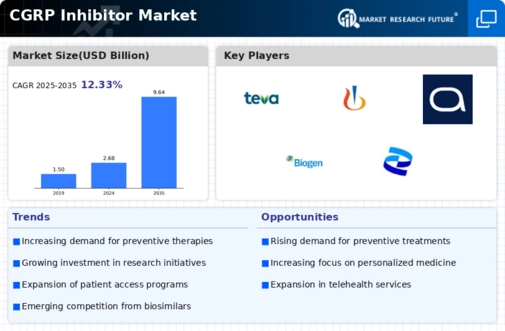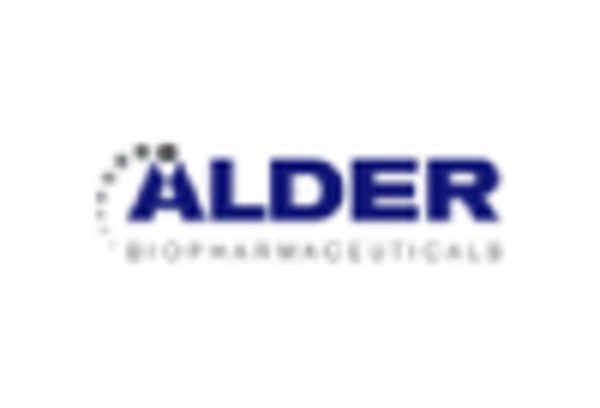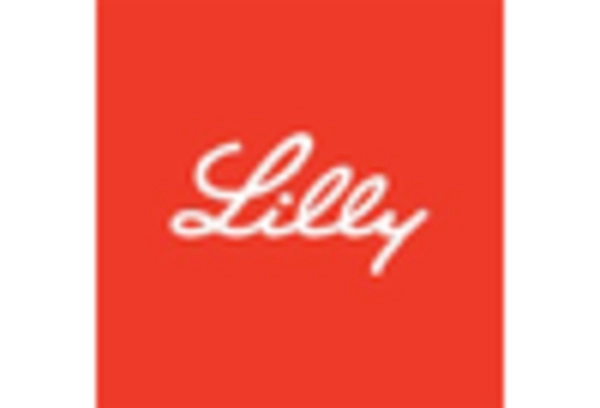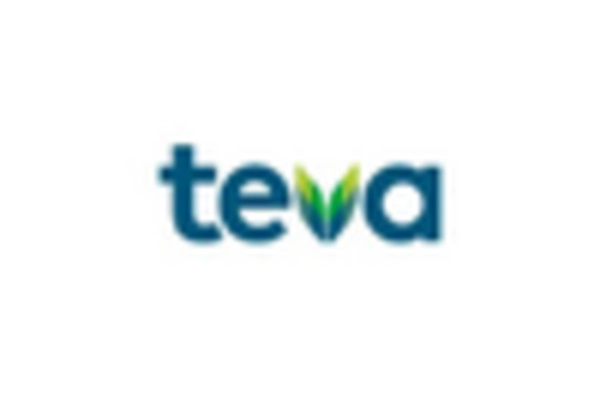Market Growth Projections
The Global CGRP Inhibitor Market Industry is projected to experience substantial growth over the coming years. With a revenue forecast of 2.68 USD Billion in 2024, the market is anticipated to expand significantly, reaching 9.64 USD Billion by 2035. This growth trajectory reflects a compound annual growth rate of 12.34% from 2025 to 2035, indicating robust demand for CGRP inhibitors. The market's expansion is driven by various factors, including rising prevalence of migraines, innovative drug development, and increased healthcare expenditure. These projections underscore the potential for CGRP inhibitors to become a cornerstone in migraine management.
Innovative Drug Development
The Global CGRP Inhibitor Market Industry is witnessing a wave of innovation, with pharmaceutical companies investing heavily in research and development. The introduction of new CGRP inhibitors, such as eptinezumab and fremanezumab, showcases the industry's commitment to providing diverse treatment options. These advancements not only enhance patient outcomes but also stimulate market growth by attracting a broader patient base. As these novel therapies gain regulatory approval and enter the market, they are likely to drive revenue growth significantly. The anticipated compound annual growth rate of 12.34% from 2025 to 2035 reflects the potential of innovative drug development to reshape the landscape of migraine treatment.
Rising Prevalence of Migraine
The increasing incidence of migraine disorders globally serves as a primary driver for the Global CGRP Inhibitor Market Industry. With an estimated 1 billion individuals affected worldwide, the demand for effective treatment options is surging. CGRP inhibitors have emerged as a promising therapeutic alternative, providing relief for patients who do not respond to traditional medications. As awareness of migraine as a debilitating condition grows, healthcare providers are more likely to prescribe CGRP inhibitors, thereby expanding their market presence. This trend is expected to contribute significantly to the market's growth trajectory, as the industry anticipates a rise in revenue from 2.68 USD Billion in 2024 to 9.64 USD Billion by 2035.
Growing Awareness and Education
The Global CGRP Inhibitor Market Industry benefits from heightened awareness and education regarding migraine management. Campaigns aimed at educating both healthcare professionals and patients about the efficacy of CGRP inhibitors are gaining traction. These initiatives are crucial in dispelling misconceptions about migraine treatments and promoting the benefits of newer therapies. As patients become more informed about their treatment options, they are more likely to seek prescriptions for CGRP inhibitors. This shift in patient behavior is anticipated to drive market growth, as the industry adapts to meet the increasing demand for effective migraine management solutions.
Increased Healthcare Expenditure
Rising healthcare expenditure across various regions is a crucial factor propelling the Global CGRP Inhibitor Market Industry. Governments and private sectors are allocating more resources towards healthcare, leading to improved access to advanced treatments. This trend is particularly evident in developed nations, where healthcare budgets are expanding to accommodate innovative therapies like CGRP inhibitors. As patients gain better access to these treatments, the demand for CGRP inhibitors is expected to rise. This increase in healthcare spending is likely to support the market's growth, contributing to the projected revenue increase from 2.68 USD Billion in 2024 to 9.64 USD Billion by 2035.
Regulatory Support and Approvals
Regulatory bodies play a pivotal role in shaping the Global CGRP Inhibitor Market Industry through their support and approval processes. The expedited approval of CGRP inhibitors by agencies such as the FDA has facilitated quicker access to these innovative therapies for patients. This regulatory environment encourages pharmaceutical companies to invest in the development of new CGRP inhibitors, fostering competition and innovation within the market. As more products receive approval, the market is likely to expand, with increased availability of treatment options for patients suffering from migraines. This supportive regulatory landscape is expected to contribute to the overall growth of the industry.

















Leave a Comment